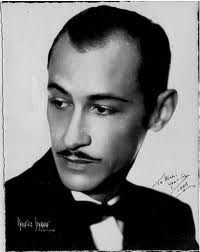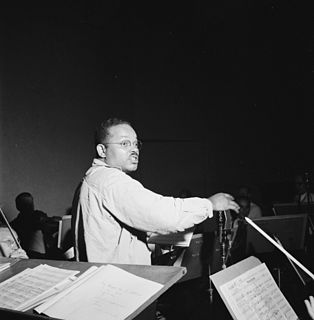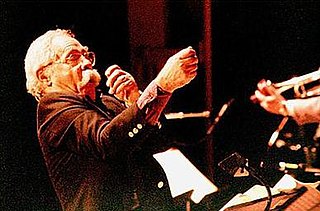Alberto Socarrás Estacio, (Manzanillo, 19 September 1908 – New York City, 26 August 1987), was a Cuban-American flautist who played both Cuban music and jazz.

Manzanillo is a municipality and city in the Granma Province of Cuba. By population, it is the 14th largest Cuban city and the most populated one not being a provincial seat.

The City of New York, usually called either New York City (NYC) or simply New York (NY), is the most populous city in the United States and thus also in the state of New York. With an estimated 2017 population of 8,622,698 distributed over a land area of about 302.6 square miles (784 km2), New York is also the most densely populated major city in the United States. Located at the southern tip of the state of New York, the city is the center of the New York metropolitan area, the largest metropolitan area in the world by urban landmass and one of the world's most populous megacities, with an estimated 20,320,876 people in its 2017 Metropolitan Statistical Area and 23,876,155 residents in its Combined Statistical Area. A global power city, New York City has been described as the cultural, financial, and media capital of the world, and exerts a significant impact upon commerce, entertainment, research, technology, education, politics, tourism, art, fashion, and sports. The city's fast pace has inspired the term New York minute. Home to the headquarters of the United Nations, New York is an important center for international diplomacy.
The music of Cuba, including its instruments, performance and dance, comprises a large set of unique traditions influenced mostly by west African and European music. Due to the syncretic nature of most of its genres, Cuban music is often considered one of the richest and most influential regional musics of the world. For instance, the son cubano merges an adapted Spanish guitar (tres), melody, harmony, and lyrical traditions with Afro-Cuban percussion and rhythms. Almost nothing remains of the original native traditions, since the native population was exterminated in the 16th century.
Socarras started learning the flute in 1915 with his mother, Dolores Estacio, and later joined the provincial music conservatory at Santiago de Cuba. He completed his studies at the Timothy Music Conservatory in New York, gaining the equivalent title to a doctorate in music. [1] In the middle 1920s he moved to Havana to join the theatre orchestra of Arquimedes Pous, where his sister Estrella was playing the violin. He also played in one or two early Cuban jazz bands (Early Cuban jazz) before moving to the United States in 1927.
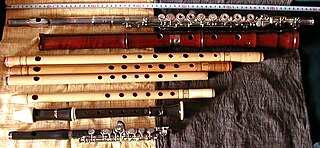
The flute is a family of musical instruments in the woodwind group. Unlike woodwind instruments with reeds, a flute is an aerophone or reedless wind instrument that produces its sound from the flow of air across an opening. According to the instrument classification of Hornbostel–Sachs, flutes are categorized as edge-blown aerophones. A musician who plays the flute can be referred to as a flute player, flautist, flutist or, less commonly, fluter or flutenist.

Santiago de Cuba is the second-largest city in Cuba and the capital city of Santiago de Cuba Province. It lies in the southeastern area of the island, some 870 km (540 mi) southeast of the Cuban capital of Havana.
In the US he recorded with Clarence Williams in 1927 with his first flute solo taking place on "Shooting the Pistol" on the Paramount label that year, making him the earliest known jazz flute soloist (earlier even than Wayman Carver). He played with The Blackbirds revue between 1928 and 1933, and plays on Lizzie Miles's 1928 recording "You're Such a Cruel Papa to Me". In 1933 he played with Benny Carter, then led the all-female Cuban band Anacaona on a tour of Europe in 1934. In 1935 he played with Sam Wooding and led his own bands from 1935 into the 1940s; his sidemen included Edgar Sampson and Mongo Santamaría, and Cab Calloway as a singer. He also played with Erskine Hawkins in 1937. He made one recording session in 1935, with four numbers. He also recorded for RCA Victor in 1947 and SMC Pro-Arte c. 1950. He recorded again in 1955, cutting Afro Cuban versions of four Duke Ellington compositions. In 1956, he recorded two LPs for Decca. In 1959, he appeared on the exotic "Tambo!" LP by Tito Puente for RCA Victor.

Clarence Williams was an American jazz pianist, composer, promoter, vocalist, theatrical producer, and publisher.
Wayman Carver was an American jazz flutist and reeds player.

Blackbirds of 1928 was a hit Broadway musical revue that starred Adelaide Hall, Bill Bojangles Robinson, Tim Moore and Aida Ward, with music by Jimmy McHugh and lyrics by Dorothy Fields. It contained the hit songs "Diga Diga Do", the duo's first hit, "I Can't Give You Anything But Love", "Bandanna Babies" and "I Must Have That Man" all sung by Adelaide Hall.
In the 1950s he took part in Rod Serling's The Twilight Zone on TV, and offered concerts of cult music at the Carnegie Hall in New York. In the 60s he dedicated himself to teaching, but also made some recordings. In 1983 he was filmed by Gustavo Paredes playing the flute in a TV documentary Música.

Rodman Edward Serling was an American screenwriter, playwright, television producer, and narrator known for his live television dramas of the 1950s and his science-fiction anthology TV series, The Twilight Zone. Serling was active in politics, both on and off the screen, and helped form television industry standards. He was known as the "angry young man" of Hollywood, clashing with television executives and sponsors over a wide range of issues including censorship, racism, and war.

The Twilight Zone is an American media franchise based on the anthology television series created by Rod Serling. The episodes are in various genres, including fantasy, science fiction, suspense, horror, and psychological thriller, often concluding with a macabre or unexpected twist, and usually with a moral. A popular and critical success, it introduced many Americans to common science fiction and fantasy tropes. The original series, shot entirely in black and white, ran on CBS for five seasons from 1959 to 1964.
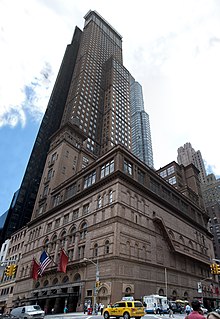
Carnegie Hall is a concert venue in Midtown Manhattan in New York City, United States, located at 881 Seventh Avenue, occupying the east side of Seventh Avenue between West 56th Street and West 57th Street, two blocks south of Central Park.




